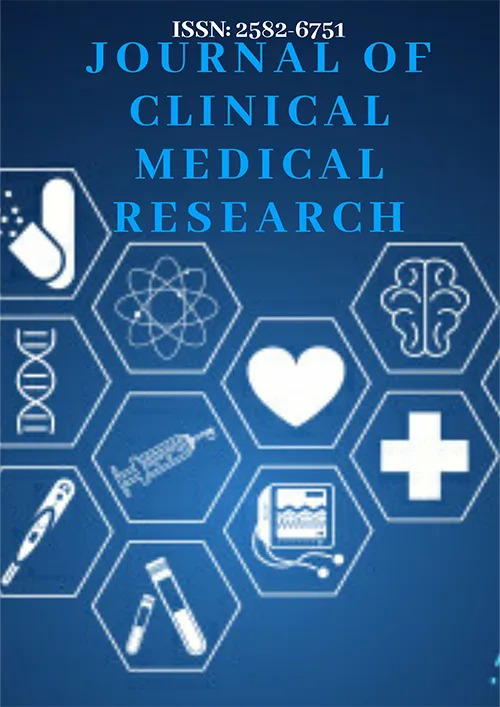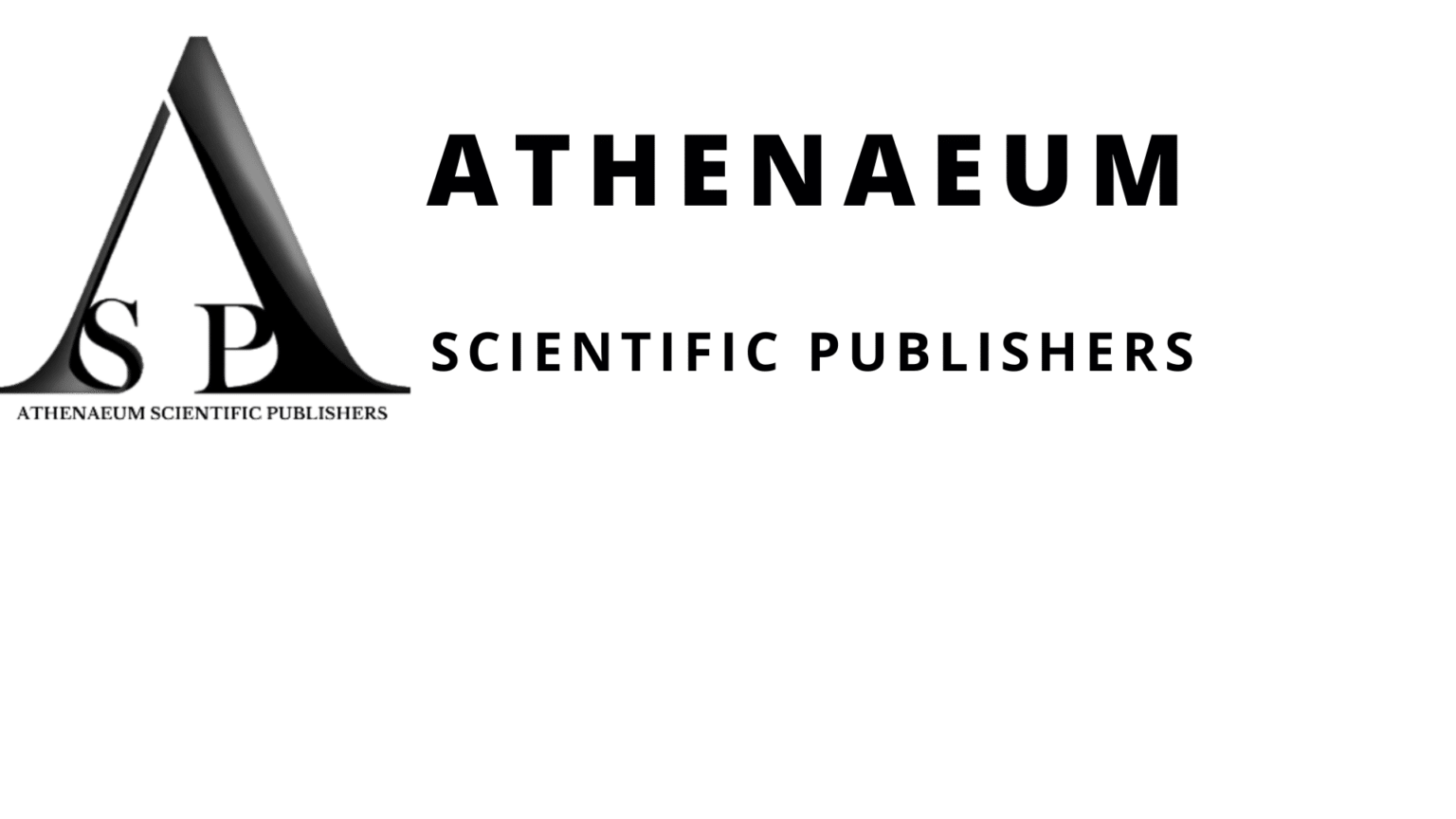Research Article | Vol. 6, Issue 1 | Journal of Clinical Medical Research | Open Access |
Superior Oral Bioavailability of Epigallocatechin Gallate from TèPigal 300®, a Dietary Supplement Versus a Cup of Green Tea
Felicia Vista1





1RandD Department of Sherman Tree Nutraceuticals, Via Tuscolana 916, 00174 Roma, Italy
2Department of Pharmacy, University of Salerno, Via Giovanni Paolo II 132, 84084 Fisciano, Italy
3Association for Research on Integrative Oncology Therapies (ARTOI), Via Ludovico Micara, 73, 00165 Rome, Italy
4Department of Oncology, S Andrea Hospital, Via di Grottarossa 1035, 00189 Roma, Italy
*Correspondence author: Massimo Bonucci, Association for Research on Integrative Oncology Therapies (ARTOI), Via Ludovico Micara, 73, 00165 Rome, Italy and Department of Oncology, S Andrea Hospital, Via di Grottarossa 1035, 00189 Roma, Italy; Email: [email protected]
Citation: Vista F, et al. Superior Oral Bioavailability of Epigallocatechin Gallate from TèPigal 300®, a Dietary Supplement Versus a Cup of Green Tea. Jour Clin Med Res. 2025;6(1):1-13.
Copyright© 2025 by Vista F, et al. All rights reserved. This is an open access article distributed under the terms of the Creative Commons Attribution License, which permits unrestricted use, distribution, and reproduction in any medium, provided the original author and source are credited.
| Received 07 April, 2025 | Accepted 22 April 2025 | Published 29 April, 2025 |
Abstract
Background: Epigallocatechin Gallate (EGCG), a potent compound found in green tea, is renowned for its multifaceted health benefits. Unfortunately, despite its therapeutic potential, the bioavailability of EGCG remains a challenge and differences in bioavailability by mode of administration significantly influence its therapeutic efficacy. Oral intake of EGCG often results in low absorption due to factors such as first-pass metabolism and limited intestinal permeability. Our study focuses on TèPigal 300®, a product containing 300 mg of EGCG, comparing its plasma concentration profile to that of green tea.
Methods and Findings: Through in-vitro dissolution studies, we observed a significant release of EGCG in alkaline pH conditions, closely mimicking the intestinal absorption environment, supporting the effectiveness of the tablet formulation in enhancing EGCG absorption. The clinical aspect of our research involved a study of 22 healthy subjects to evaluate the relative bioavailability of EGCG, based on plasma concentration profiles (AUC) of EGCG from one tablet of TèPigal 300® in comparison with the consumption of one cup of green tea. Notably, in 10 healthy subjects EGCG was detectable in the bloodstream within 15 minutes, with increasing levels up to 60 minutes. This pattern suggests efficient absorption following EGCG release. Further comparison with the consumption of 1 cup of green tea in 12 healthy subjects highlighted the superior oral bioavailability of EGCG from TèPigal 300® tablets over tea beverage intake, quantifying this difference as one TèPigal 300® tablet being equivalent to consuming 21 cups of green tea.
Conclusion: our study underlines TèPigal 300® advantage in providing a more efficient convenient form of EGCG consumption, leading to potentially greater health benefits. Our promising results open avenues for future research on improving EGCG bioavailability through new technologies and nutrients synergies.
Keywords: Dietary Supplement; Camellia Sinensis; Epigallocatechin Gallate (EGCG); Green Tea
Introduction
In recent years, the demand for dietary supplements such as vitamins, minerals and herbal extracts has grown enormously, reflecting the rising worldwide community request for natural, safe and healthy bioactive products. The global nutraceutical market of botanical drugs based on traditional herbal medicine, is undergoing a huge expansion, hand in hand with the development of novel formulations and sustainable technologies, for the realization of time released and more highly bioavailable dosage forms of nutrients, able to improve people’s health, longevity and quality of life [1-4]. Green tea (Camellia sinensis) is one of the most ancient cultivated medicinal plants and also one of the most popular drinks consumed worldwide due to its beneficial effects in disease prevention attributed to the high content of polyphenolic flavonoid compounds, known as catechins [5]. Among catechins, Epigallocatechin Gallate (EGCG) is the most significant active component of green tea [6], as the EGCG makes up 40 to 48% of the total catechin content and is widely considered the most biologically active of them all [7-12]. EGCG shows strong antioxidant power, capable of counteracting cellular damage caused by free radicals and providing anti-inflammatory, anticarcinogenic and antimicrobial actions [13]. The chemopreventive action is attributed to the antiproliferative activity of EGCG, which interferes with intracellular signaling, inhibits cell growth and induces apoptosis [14,15]. Emerging evidence suggests that EGCG targets several critical cancer processes, interfering with key signaling pathways such as ERK, PI3K/Akt/mTOR and p53, which are essential for cancer cell survival and growth [16,17]. It promotes apoptosis in cancer cells by acting on the 67 kDa laminin receptor (67LR) and nitric oxide production [18]. EGCG also inhibits NF-κB, reduces telomerase activity in cancer cells and disrupts processes like angiogenesis and metastasis by down-regulating MMP proteins [19, 20]. Additionally, it enhances immune system activity by reducing immunosuppressive cells and targeting PD-1/PD-L1, showing promise as a cancer therapy [21]. Moreover, clinical studies have shown that both coffee and green tea consumption have been associated with a reduced risk of Hepatocellular Carcinoma (HCC) and Breast Cancer (BC), including BC recurrence, though further research is needed to confirm these protective effects [22,23].
Several studies have shown that EGCG reduces the risk of developing type 2 diabetes and related cardiovascular complications [24]. EGCG has been shown to improve insulin sensitivity, glycemic control and lipid profiles when taken long-term. It helps reverse pancreatic β-cell damage, targets microRNA (miR-16-5p) to increase insulin secretion and inhibits selenoprotein P to improve insulin resistance [25]. Theasinensin A, an oxidation product of EGCG, enhances its antioxidant capacity, aiding in hyperglycemia control [26]. Studies show that EGCG reduces fasting blood glucose, body weight and inflammatory markers, suggesting its potential as a therapeutic option for managing diabetes [27].
Regular consumption of green tea or EGCG is also associated with a reduced risk of Cardiovascular Diseases (CVD) and mortality [28]. It lowers LDL cholesterol, plasma glucose and inflammatory markers while reducing oxidative stress [29]. Green tea has also been shown to improve endothelial function and arterial dilation, especially in coronary artery disease patients [30]. Animal and human studies confirm that both green tea and EGCG reduce blood pressure and inflammation, with specific benefits in conditions like hypertension [31].
EGCG is also effective against multiple viral infections by inhibiting the infectivity of viruses such as HSV, hepatitis B and C, influenza, HIV and Ebola. It binds to viral surface proteins, preventing them from attaching to host cells. In some cases, its antiviral effectiveness rivals that of specific antiviral drugs, with studies suggesting EGCG may reduce HPV-induced cervical lesions by blocking key viral oncoproteins [32].
Furthermore, a cross-analysis of data has revealed a correlation between high consumption of green tea and a reduced risk of cognitive decline and the onset of neurodegenerative diseases such as Alzheimer’s and Parkinson’s diseases [33]. Neurodegenerative diseases like Alzheimer’s (AD) and Parkinson’s (PD) share common features such as oxidative stress, mitochondrial dysfunction and inflammation [34]. EGCG helps alleviate these issues by reducing Aβ aggregation and oxidative stress, while suppressing pro-inflammatory cytokines [35]. Research suggests that regular consumption of green tea may reduce the risk of cognitive decline and neurodegenerative diseases. Green tea consumption has been particularly associated with a protective effect against Parkinson’s disease, especially in populations with higher intake. EGCG shows promise in mitigating PD by reducing oxidative damage and improving mitochondrial function [35].
EGCG, thus, is recognized as an important bioactive molecule, with a noticeable activity as antioxidant and antitumor. However, the stability of EGCG is poor, EGCG is sensitive to oxidation and presents a low absorption rate and then to exploit its therapeutic potential its bioavailability needs to be improved [36,37]. Indeed, the scientific community is continuously searching methods for EGCG bioavailability increase, with purpose to rise its bioactivity [38]. In particular, EGCG bioavailability is extremely low in orally administered EGCG (perhaps < 3.5% of the dose) [39] and currently, not all factors contributing to the irregular plasma levels of this compound are known [40,41]. Pharmacokinetic studies conducted on the molecule have identified a significant limitation in achieving good bioavailability during the absorption phase, which should occur in the small intestine: most of the ingested EGCG ends up in the large intestine, where it undergoes degradation mediated by the local microbiota [42]. Other factors that reduce the concentration of EGCG include high pH (4 or higher) and high temperatures (above 20 °C), which decrease the structural stability of the molecule, promoting its degradation [43]. Food can also influence the oral bioavailability of EGCG, negatively but also positively when taken with specific nutrients such as fatty acids, vitamins (ascorbic acid) and minerals [44]. In the distribution phase of EGCG, according to some studies, a key role is played by serum albumin, which, through reversible interactions with the molecule, exerts a stabilizing and protective action against oxidative processes [45]. Finally, the hydrophilic nature of the molecule poses an obstacle to achieving optimal plasma concentrations, which could be overcome by structural modifications through esterification with aliphatic molecules that improve its physical properties [46]. In the latter case, it is important to consider that lyophilized EGCG, due to its structural modification, could be considered an unauthorised food, a “novel food,” and therefore an unsafe product according to stringent European Regulation.
Since there are few studies in the literature on finished products based on green tea extracts and moreover, some available data are conflicting, to prove the effectiveness and safety of a new food supplement containing EGCG, the TèPigal 300® product, in this paper TèPigal 300® tablets dissolution test and in-vivo control study have been performed with the aim of showing the appropriate formulation of the commercial product suitable to achieve a favorable EGCG plasma concentration. Therefore, the objective of this study was to compare the EGCG from a single tablet of TèPigal 300® and one cup of green tea by assessing its presence in blood samples.
Ethical Statement
The project did not meet the definition of human subject research under the purview of the IRB according to federal regulations and therefore, was exempt.
Materials and Methods
Materials
TèPigal 300® tablets, as commercialized, are used for in-vivo and in-vitro tests. Tèpigal 300® is primarily composed of Epigallocatechin Gallate (EGCG) sourced from the dry extract of Camellia sinensis L. Kuntze leaves. The EGCG extract in TèPigal 300® is titrated to 95%, ensuring a high concentration of the active compound. The formulation includes several excipients to ensure the stability and bioavailability of the product, i.e. (Bulking Agent: Microcrystalline cellulose, Anti-caking Agents: dibasic calcium phosphate, glycerol dibehenate and vegetable magnesium stearate).
Commercial Green Tea Preparation: For the green tea beverage, we used commercially available green tea sachets from three widely consumed brands in the Italian market. Each sachet contained an average of 1.6 ± 0.1 grams of green tea leaves (measured by precision scale). The tea was prepared following a standardized protocol: each sachet was infused in 200 milliliters of freshly boiled water (100°C) for exactly 3 minutes. After infusion, the tea was filtered and allowed to cool to approximately 60°C before administration to participants. For the preparation, three different widely available market brands of green tea were used, ensuring the results are representative of commonly consumed products. Based on published data, the average EGCG content per cup of green tea prepared under these conditions is estimated to be approximately 60-90 mg [47].
Water (H2O), acetonitrile (ACN), methanol (MeOH), formic acid (HCOOH), hydrochloric acid (HCl), tri-basic sodium phosphate (Na3PO4) and acetic acid (CH3COOH) LC-MS grade, as well as reagent-grade di-methyl sulfoxide (DMSO), were all purchased from Merck (Milan, Italy). The authentic standard (-) Epigallocatechin 3-Gallate (EGCG) was acquired from Merck Sigma-Aldrich. Unless otherwise stated, all other re-agents were obtained from Merck.
In-vitro Studies: Apparatus and Protocol
The standard dissolution procedure (711 Dissolution chapter of United States Pharmacopeia USP) involves the use of a USP II apparatus. In this study, the AT7 Smart Paddle (Sotax) dissolution tester equipped with the Lambda 35 UV/VIS spectrophotometer (Perkin-Elmer), was used. In particular, the in-vitro drug release study has been performed under simulated gastrointestinal conditions by using six vessels (and one vessel was used with dissolution medium as control) following this procedure: 1 tablet of TèPigal 300® was put in each vessel (in total six tablets are used) with 750 mL of 0.1 N hydrochloric acid (pH 1), simulating the stomach pH; after 2 h (120 min), 250 mL of a solution of 0.2 M tribasic sodium phosphate was added to reach pH 6.8, simulating the intestine pH, according to USP suggestions. The control vessel was used to contain only the buffer solutions (first the hydrochloric acid then the tribasic sodium phosphate) to be assayed as blank in spectrophotometric measures. The temperature was kept at 37°C under accurately controlled stirring conditions of 100 rpm. 5 mL of dissolution bulk were withdrawn at different time intervals (15 min) and spectrometrically analyzed. After measurements, the analyzed volume was reintroduced in the bulk solution.
Results of dissolution tests have been reported as released and cumulatively released EGCG as a function of time. Cumulative release is evaluated by the following equation:
![]()
All the measurements were performed in triplicate and results were expressed as average values with standard deviation.
Spectrophotometric Detection of EGCG: Calibration Procedure
Solutions with different EGCG concentrations were prepared in deionized water. Since the active substance has a maximum absorbance in the UV region, a spectrum of absorption in the range 200 nm – 400 nm assayed spectrophotometrically and the the λ(max) = 274 nm was selected, according with literature [48,49]. Although the product tends to degrade, no changes in absorbance measurements were found during the time required to conduct the dissolution tests [49]. With this indication, we proceeded to measure the absorbances of the different standard solutions to obtain the calibration line (Lambert-Beer law: A = K · C; R2 = 0.9999). The value of the determined K constant is 0.0244 mL/μg. This value is similar to the values obtained for EGCG released in buffer solutions at pH 1 and pH 6.8, solutions used for the dissolution tests. Results were reported as mean values of six cumulative values with SD.
In-vivo Studies: Participants and Protocols
Twenty-two healthy volunteers were recruited for this study. All participants underwent a health examination prior to the start of the study to assess their health status. The volunteers were adult individuals of both sexes and had no pre-existing medical conditions. The intake of the tablets and green tea occurred early in the morning, with all participants in the study being on an empty stomach (fasting state condition); no one had taken green tea the day before.
In the study, subjects were divided into two groups: the first group consumed 1 green tea bag, selected among the most popular Italian brands, while the second group ingested 1 TèPigal 300® tablet, facilitating a comparative analysis of health outcomes between traditional tea consumption and concentrated supplement intake.
After ingesting a cup or 1 tablet of the green tea product with a glass of water, each participant underwent three blood samples at different time points: 15 minutes (T0), 60 minutes (T1) and 120 minutes after intake. None of the participants experienced any physical problems from taking this product. Informed consent was obtained from all participants before the start of the study.
Extraction
All blood samples were collected in tubes containing EDTA anticoagulant. To separate the plasma, the blood samples were centrifuged at 6000 rpm at 4 °C for 15 minutes. The supernatants containing the plasma were aliquoted into 1 mL vials for cryopreservation and immediately stored at -80 °C. At the time of extraction, the plasma samples were thawed on ice. 25 μL of each sample were extracted with 100 μL of a solution of MeOH + 0.1% HCOOH (v/v). The samples were vortexed at 4 °C for 6 minutes and finally centrifuged at 14680 rpm for 10 minutes at 4 °C. 95 μL of the supernatant were collected and injected directly into UHPLC-HRMS.
Instrumentation
UHPLC-HRMS analyses were performed on a Thermo Ultimate RS 3000 UHPLC system coupled online to a quadrupole Orbitrap Q-Exactive mass spectrometer (Thermo Fisher Scientific, Bremen, Germany) equipped with a heated electrospray ionization (HESI II) source.
For RP-UHPLC analysis, a Luna® Omega polar C18 column (50 × 2.1 mm; 1.6 μm, 100Å) protected with a SecurityGuardTM ULTRA pre-column (5 × 2.1 mm) (Phenomenex, Bologna, Italy) was used. The oven temperature was set at 45 °C, the mobile phase flow rate was set at 0.5 mL/min and the mobile phase consisted of (A): H2O + 0.1% CH3COOH (v/v) and (B): ACN + 0.1% CH3COOH. The following 8-minute elution gradient was used: 0-4 min, 5%-40% B, 4.01-4.1 min, 40-98% B, isocratic at 98% B for 1 min and return to the initial conditions of the chromatographic gradient in 0.1 min. A total of 3 µL was injected.
The MS detection was performed in negative mode (ESI-). HRMS analyses were carried out in targeted Single Ion Monitoring (t-SIM) mode by building an inclusion list based on the molecular formula and accurate mass of the compound: m/z EGCG, 457.0763.
A mass resolution of 35,000 FWHM at m/z 200 was selected. The following source parameters were set: Sheath gas pressure, 50 arbitrary units; auxiliary gas flow, 13 arbitrary units; spray voltage, +3.5 kV, -2.8 kV; capillary temperature, 300 °C; auxiliary gas heater temperature, 300 °C; S-lens RF value: 50 arbitrary units. Three instrumental replicates were performed for each sample. The samples were analyzed in a random order to prevent any variation in the sensitivity of the mass spectrometer and the Quality Control (QC) consisting of a pool of different samples mixed in the same ratio was randomly inserted within the analysis sequence to monitor system stability over time.
Instrument Calibration and Method Validation
Instrumental calibration was performed using the external standard method. The stock solution (1 mg/mL) of the authentic standard was prepared in MeOH. Subsequent serial dilutions were carried out in MeOH and the final calibration curve was prepared in a matrix of previously extracted virgin plasma. The calibration curve was obtained over a concentration range of 1-500 ng/mL, with five concentration levels. Linear regression was used to generate the calibration lines with R2 values ≥ 0.999. For sensitivity assessment, the Limits Of Detection (LOD) and Quantification (LOQ) were calculated as the ratio of the Standard Deviation (SD) to the slope of the analytical curve, multiplied by 3 and 10, respectively. Intra- and inter-day instrumental repeatability was established by performing repeated injections of the Quality Control (QC) sample under the same chromatographic conditions, by the same analyst, on the same day and within two consecutive days. The results were expressed as the Coefficient of Variation (CV%) for concentration and retention time. Recovery was evaluated in addition to blank plasma samples of EGCG at low, medium and high concentrations, which were subsequently extracted and analyzed as described earlier (Table 1).
LOD | LOQ | CV% Intra-day | CV% Inter-day | Recovery % | Matrix Effect % | ||
Tr | ng/mL | Tr | ng/mL | ||||
0.273 ng/mL | 0.909 ng/mL | 0.010 | 2.422 | 0.259 | 0.286 | 86.35 ± 1.66 | 9.122 |
Table 1: Parameters for analytical method validation of EGCG.
Area Under the Plasma Concentration-Time Curve (AUC) Calculation
The Area Under the Plasma Concentration-Time Curve (AUC) was calculated for both groups using the trapezoidal rule over the time interval of 15 to 120 minutes. This computational approach allows for an accurate estimation of the drug exposure in the blood plasma over a significant period following administration.
Statistical Analysis
Results are expressed as the observed mean ± Standard Deviation (SD). The Mann-Whitney U test was employed to calculate adjusted P values from the models, with a significance level set at p < 0.05.
Results
Tests In-vitro
According to the procedures previously described the behavior of the TèPigal 300® tablets in bulk dissolution was observed with the aim of highlighting release, swelling and erosion phenomena due to the diffusion of the liquid medium within the solid matrix. Visual observations showed that the TèPigal 300® tablets remained practically intact until 45 min of testing at pH 1 (Fig. 1). After this period, swelling phenomena started and, subsequently, erosion effects became evident. At 120 min, just before carrying out the pH change, the tablets are partially disintegrated (Fig. 1), as also confirmed by the cumulative release data equal to an average value of 60% (Fig. 2). The high standard deviation corresponding to the 120 min data is due to the different degree of disintegration of the tablets.
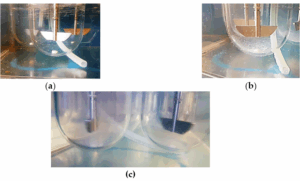
Figure 1: TèPigal 300® tablets in buffer solutions at 37°C after: a) 45 min at pH 1; b) 120 min at pH 1; c) 135 min at pH 6.8.
After roughly 15 minutes after the pH change of the dissolution medium, the EPGC is almost completely released (approximately 85%, see cumulative release in Fig. 2). Also in this case, the high standard deviation corresponding to the data at 135 min is due to the different degree of disintegration of the tablets, in particular, out of three tablets, two are completely disintegrated, one is still partially aggregated (Fig. 1). The dissolution tests were considered closed after 165 min. Indeed, successive assay of EGCG shows constant values (Fig.2).

Figure 2: Cumulative release of EGCG during the in-vitro dissolution tests.
Release profiles show that in a gastric simulated environment (pH 1) the release of EGCG follows a 0-order kinetics due to a linear relationship between the quantity of EGCG released and time. At pH 6.8 the EGCG release is more massive due to the complete disaggregation of the solid matrix in 45 min.
Epigallocatechin 3-Gallate (EGCG) Assay in Blood Samples from “TèPigal 300®” Consumers
The plasma EGCG concentrations were quantified by UHPLC-HRMS. Fig. 3 shows the extract ion chromatograms of a blank (plasma from a control) and a real sample. As can be observed, no interfering peaks at the retention time of the EGCG peak were detected in the blank sample.
EGCG contained in TèPigal 300® was measured in the blood plasma of 10 consumers at 3 different time points (15, 60 and 120 minutes after TèPigal 300® ingestion). Fig. 4 show the absolute and average EGCG trends over time.
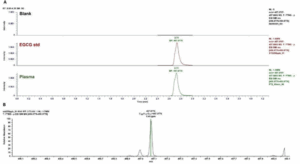
Epigallocatechin 3-Gallate (EGCG) Assay in Blood Samples from “TèPigal 300®” Consumers
The plasma EGCG concentrations were quantified by UHPLC-HRMS. Fig. 3 shows the extract ion chromatograms of a blank (plasma from a control) and a real sample. As can be observed, no interfering peaks at the retention time of the EGCG peak were detected in the blank sample.
EGCG contained in TèPigal 300® was measured in the blood plasma of 10 consumers at 3 different time points (15, 60 and 120 minutes after TèPigal 300® ingestion). Fig. 4 show the absolute and average EGCG trends over time.
The average quantity of EGCG was 0.1 ± 0.08 µmol/L at 15 min, followed by 1.32 ± 1.05 µmol/L after 60 minutes, which was the maximum average concentration reached, that decreased to 1.07 ± 0.46 µmol/L after 120 minutes post-administration (that translates into 47.38 ± 34.27 µg/L, 602.93 ± 481.79 µg/L and 444.73 ± 218.28 µg/L, respectively).
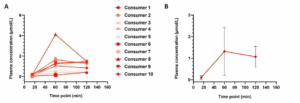
Figure 4: Plasma concentration (µmol/L)-time (min) curve of Epigallocatechin 3-gallate (EGCG) depicted for 10 subjects consuming TèPigal 300® (A) and as average amount; (B). Values are expressed as µmol/L and are represented as the mean with ± SD.
Epigallocatechin 3-Gallate (EGCG) Assay in Blood Samples from Green Tea Consumers
EGCG contained in green tea was measured in the blood plasma of 12 consumers at 3 different time points (15, 60 and 120 minutes after Tea ingestion). Fig. 5 show the absolute and average EGCG trends over time. The average quantity of EGCG was 0.038 ± 0.020 µmol/L at 15 min, followed by 0.049 ± 0.020 µmol/L after 60 minutes and 0.047 ± 0.016 µmol/L after 120 minutes post-administration (that translates into 17.563 ± 8.957 µg/L, 22.332 ± 9.047 µg/L and 21.245 ± 6.921, respectively).
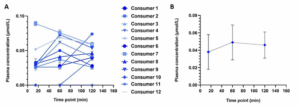
Figure 5: Plasma concentration (µmol/L)-time (min) curve of Epigallocatechin 3-Gallate (EGCG) depicted for 12 subjects consuming Green tea (A) and as average amount; (B): Values are expressed as µmol/L and are represented as the mean with ± SD.
Area Under the Plasma Concentration Time-Curve (AUC) of Plasma Total ECGC After Consumption of TèPigal 300® or Green Tea Consumers
The Area Under the Plasma Concentration-Time Curve (AUC) was calculated for EGCG in both groups over the 15-120 minute post-consumption period. The AUC for the TèPigal 300® group (103.65 µmol/L*min) was approximately 21-fold higher than the green tea group (4.83 µmol/L*min). This indicates substantially higher short-term plasma exposure to EGCG following tablet consumption compared to a single cup of green tea during the initial absorption phase (Table 2).
| TèPigal 300® | Green Tea |
AUC-15-120 min | 103.65 µmol/L*min | 4.83 µmol/L*min |
Table 2: AUC of plasma total ECGC after consumption of TèPigal 300® or Green tea consumers.
Epigallocatechin 3-Gallate (EGCG) Assay in Blood Samples from TèPigal 300® and Green Tea Consumers
The comparative analysis of the plasma concentration of EGCG in subjects who consumed TèPigal 300® or a cup of green tea, as shown in Fig. 6 reported in Table 3, highlights a statistically significant increase in the plasma levels of the active ingredient at 15, 60 and 120 minutes for those who took TèPigal 300®. These data suggest that TèPigal 300® results in superior oral bioavailability, as reflected by higher plasma concentrations of EGCG compared to green tea, indicating a significantly greater systemic availability of EGCG from the tablet.
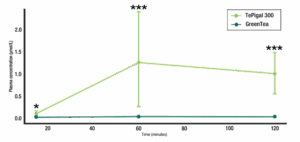
Figure 6: Plasma concentration (µmol/L)-time (min) curve of Epigallocatechin 3-gallate (EGCG) for 10 subjects assuming TèPigal 300® and 12 subjects consuming Green. Values are expressed as µmol/L and are represented as the mean with ± SD; *p< 0.05, ***p<0.001 vs green tea.
Plasma Average ECGC | Green Tea | TePigal 300® |
15 Minutes | 0.038 ± 0.020 µmol/L | 0.1 ± 0.08 µmol/L* |
60 Minutes | 0.049 ± 0.020 µmol/L | 1.32 ± 1.05 µmol/L*** |
120 Minutes | 0.047 ± 0.016 µmol/L | 1.07 ± 0.46 µmol/L*** |
Table 3: Plasma concentration Epigallocatechin 3-Gallate (EGCG) for 10 subjects assuming TèPigal 300® and 12 subjects consuming Green. Values are expressed as µmol/L and are represented as the mean with ± SD; *p< 0.05, ***p<0.001 vs green tea.
Discussion
Epigallocatechin Gallate (EGCG) from green tea possesses numerous health-promoting activities, including anti-inflammatory, anticarcinogenic and antimicrobial effects [1]. It exhibits antiproliferative properties that interact with intracellular signaling, inhibit cell growth and induce apoptosis [2]. Additionally, EGCG may offer potential benefits for type 2 diabetes and cardiovascular complications [24].
Historically, the absolute bioavailability of EGCG has been markedly low, approximately 0.1% in rat models, a phenomenon commonly attributed to its poor membrane permeability and the action of intestinal efflux transporters [40,41]. Moreover, the bioavailability of EGCG is influenced by several interrelated factors. One important factor is the timing of intake relative to meals. Taking EGCG on an empty stomach generally results in higher peak plasma concentrations and greater overall absorption. This is because the gastrointestinal tract is less stimulated in the absence of food, allowing EGCG to be absorbed more efficiently without competing with other nutrients or undergoing significant digestive processing. The gastrointestinal environment also plays a crucial role in EGCG absorption. When the stomach is empty, it maintains a more acidic pH, which helps to stabilise EGCG and minimise its degradation. In contrast, when food is present, the pH can shift to a more neutral or basic level due to the release of bile and pancreatic juices. This change can negatively affect the solubility and stability of EGCG, potentially leading to reduced bioavailability [45,46].
In addition, interactions with other dietary components further complicate the absorption of EGCG. The presence of various nutrients, such as fats, proteins and fibres, can alter digestion and absorption rates. For example, certain foods may bind to EGCG or slow gastric emptying, delaying its entry into the small intestine where absorption primarily occurs. These dietary factors can lead to significant variability in how effectively EGCG is absorbed and utilised in the body. Overall, the interplay between these factors highlights the importance of considering the conditions under which EGCG is consumed in order to optimise its health benefits.
Our study investigates the oral bioavailability of TèPigal 300®, which contains 300 mg of EGCG extracted from Camellia sinensis titrated to 95% of EGCG, by evaluating its plasma concentrations. This high level of purity of the extract, not only facilitates the delivery of a substantial dose of EGCG in a single tablet but also potentially improves its absorption. The limited presence of structurally similar EGCG compounds, which could compete with or inhibit the uptake of EGCG, further facilitates its absorption.
First of all, based on the results obtained from analyses of continuously updated batches, it has been highlighted that the production, which adheres more and more to good manufacturing practices, the selection and quality controls on raw materials, proper storage at ideal temperatures and effective packaging for preserving TèPigal 300® tablets have led to high quality products.
In order to assess the quality, we conducted in-vitro dissolution studies of TèPigal 300® tablets, focusing on EGCG release across two pH levels. The results indicate that the tablets release more EGCG in alkaline conditions, mirroring the intestinal environment where absorption is most effective [50]. This finding suggests that the formulation of TèPigal 300® is adequate for the guarantee of the correct disintegration of the tablet. This process is essential as it is the first step toward ensuring the proper oral bioavailability of the active compound, EGCG. By validating that the tablets disintegrate effectively at the appropriate pH levels-we can be confident that the formulation is correctly designed to release the EGCG in a manner that facilitates its absorption. This correct formulation is crucial, as it lays the foundation for the effective bioavailability of EGCG, ensuring that the high-purity extract contained within each TèPigal 300® tablet can be efficiently absorbed and utilized by the body.
A clinical evaluation involving 22 healthy subjects provided additional insights into the oral bioavailability of EGCG from TèPigal 300®.
The results obtained in this study regarding the average plasma concentrations of EGCG are interesting. In 10 healthy subjects who assumed TèPigal 300®., after 15 minutes, we found EGCG in the blood of almost all the patients. In all patients, the EGCG levels were growing after 60 minutes. In five patients, the plasma concentration was reduced after 120 minutes, while in the remaining five, it stayed high. The results after 60 and 120 minutes were 602.93 µg/L and 444.73 µg/L, respectively. When compared to values reported in the literature for both raw extract and the few finished products that have been scientifically studied, they are not only comparable but also higher [44,48]. Although, our data not only demonstrate comparability but also exhibit consistency in absorption kinetics, particularly aligning with those of other ECGC-based products [44], a deviation can be observed when comparing these results to our in-vitro data.
Observing the in-vitro release profiles of EGCG from TèPigal 300®, tablets allows us to note a discrepancy with the plasma release profiles. However, it is known that the dissolution protocol with the paddle system device presents limitations in the reproduction of real physiological conditions due to chemical-physical factors (variability of pH after the intake of meals, volume of meals and contents, quantity of secretions and their variation of the gastro-intestinal pathway) and fluid dynamics (gastric peristalsis, intestinal motility) [50, 55]. Nevertheless, it remains a valid tool for the technological control of formulation suitability, as above discussed.
To further assess the oral bioavailability of EGCG in TèPigal 300®, in addition to comparing with existing literature data, we decided to measure the plasma levels of this active compound in 12 healthy subjects who consumed green tea cups, which are naturally rich in EGCG. This approach allows for a direct and practical evaluation of EGCG’s presence and absorption from both sources, offering a comprehensive understanding of the compound’s oral bioavailability. The comparison between consuming a TèPigal 300® tablet and a cup of green tea reveals significantly limited EGCG levels in plasma following tea consumption; the results in tea bag consumers after 60 and 120 minutes were 22.332 µg/L and 21.245 µg/L respectively.
When comparing the plasma exposure between a single TèPigal 300® tablet and one cup of green tea, we found that the AUC ratio in the 2-hour post-consumption window was approximately 21:1. Thus, although the TèPigal 300® tablet provides approximately 3 to 5 times the EGCG content of one cup of tea, it achieves a 21-fold higher plasma exposure (AUC).This suggests that the initial EGCG absorption from one TèPigal 300® tablet provides plasma exposure equivalent to what would theoretically require 21 cups of green tea. However, it’s important to note that this comparison is limited to the acute absorption phase (0-2 hours) and may not represent total bioavailability or longer-term pharmacokinetics. Additionally, the simplified numerical comparison should be interpreted with caution as factors such as saturable absorption mechanisms, biotransformation differences and elimination kinetics at higher doses were not assessed in this study.
This limitation is attributed to the reduced and non-standardized concentration of the active principle in the tea bag and is due to the poor bioavailability of EGCG in tea. In contrast, plasma EGCG levels after tablet intake, which is formulated to release 300 mg of EGCG, are significantly higher. This offers a dual advantage to the consumer: the tablet not only simplifies intake and facilitates daily management but also ensures the release of EGCG with superior oral bioavailability, achieving plasma concentrations that could hardly be attained even by consuming multiple cups of tea.
Limitations of the Study
Several limitations must be taken into account when interpreting the results of this study. First, the sample size was relatively small, with only 22 participants, which limits the generalizability and statistical power of the findings. The study was open-label and not double-blind, which introduces the possibility of biases in the administration of EGCG, as participants and researchers were aware of the type of intervention.
Additionally, the study focused solely on comparing the plasma concentrations of EGCG from tablet form versus green tea, without assessing any potential health effects or clinical outcomes. Therefore, while the results provide insight into the bioavailability of EGCG in different forms, they do not address the potential therapeutic or health-related benefits of EGCG. A more comprehensive study, including a larger and more diverse sample, as well as a randomized controlled trial design, would be necessary to better understand the clinical implications of these findings. Future research should also explore the effects of EGCG on various health parameters to determine its broader impact.
In conclusion, while this study provides useful data on the plasma concentration differences between EGCG in tablets and green tea, further investigations are needed to assess the clinical relevance of these findings.
Conclusion
In conclusion, our study demonstrates a statistically significant increase in the plasma exposure of EGCG from TèPigal 300® tablets compared to traditional green tea infusion. Although the EGCG content in a single TèPigal 300® (300 mg) tablet is only 3 to 5 times higher than the estimated EGCG dose from one cup of green tea (60-90 mg), the observed plasma concentration during the first 2 hours post-ingestion was approximately 21 times greater. This disproportionate increase indicates a marked improvement in oral bioavailability, likely due to formulation strategies that enhance EGCG’s solubility, stability and intestinal absorption. These findings suggest that TèPigal 300® offers a practical and efficient alternative to green tea for achieving higher systemic EGCG levels. Further pharmacokinetic investigations over longer time periods are warranted to fully characterize its absorption profile. Additionally, future studies may explore synergistic formulation techniques and delivery systems aimed at maximizing the therapeutic potential of EGCG through enhanced bioavailability.
Conflict of Interest
The authors declared no potential conflicts of interest with respect to the research, authorship and/or publication of this article. M.R., M.D.C. and F.V. are employees of Sherman Tree Nutraceuticals S.r.l. and D.D.F. serve as consultants for Sherman Tree Nutraceuticals SRL
Acknowledgement
All UHPLC-HRMS analyses were carried out at the Department of Pharmacy, University of Salerno, under the supervision of Prof. Eduardo Sommella. Sherman Tree Nutraceuticals S.r.l. provided the TèPigal 300® tablets used in the study.
Consent to Participate
Informed consent was also obtained from each subject who participated in the study.
Financial Disclosure
This research was partially funded by Sherman Tree Nutraceuticals SRL.
Data Availability
Data is available for the journal. Informed consents were not necessary for this paper.
Author’s Contribution
The authors contributed equally.
References
- Ahn K. The worldwide trend of using botanical drugs and strategies for developing global drugs. BMB Reports. 2017;50:111-6.
- Altemimi AB, Farag HAM, Salih TH, Awlqadr FH, Al-Manhel AJA, Vieira IRS, et al. Application of nanoparticles in human nutrition: A review. Nutrients. 2024;16:636.
- Chauhan B, Kumar G, Kalam N, Shahid H, Ansari SH. Current concepts and prospects of herbal nutraceutical: A review. J Advanced Pharmaceutical Technology and research. 2013;4:4-8.
- Dwyer JT, Coates PM, Smith MJ. Dietary supplements: regulatory challenges and research resources. Nutrients. 2018;10:41.
- Musial C, Kuban-Jankowska A, Gorska-Ponikowska M. Beneficial Properties of Green Tea Catechins. Int J Mol Sci. 2020;21:1744.
- Kim JA, Formoso G, Li Y, Potenza MA, Marasciulo FL, Montagnani M, Quon M. Epigallocatechin gallate, a green tea polyphenol, mediates no-dependent vasodilation using signaling pathways in vascular endothelium requiring reactive oxygen species and Fyn. J Boil Chem. 200;282:13736-45.
- Cerbin-Koczorowska M, Waszyk-Nowaczyk M, Bakun P, Goslinski T, Koczorowski T. Current view on green tea catechins formulations, their interactions with selected drugs and prospective applications for various health conditions. Appl Sci. 2021;11:4905.
- Braicu C, Ladomery MR, Chedea VS, Irimie A, Berindan-Neagoe I. The relationship between the structure and biological actions of green tea catechins. Food Chemistry. 2013;141(3):3282-9.
- Shirakami Y, Shimizu M. Possible mechanisms of green tea and its constituents against cancer. Molecules. 2018;23:2284.
- Farhan M. Green tea catechins: Nature’s way of preventing and treating cancer. Int J Mol Sci. 2022;23(18):10713.
- Kochman J, Jakubczyk K, Antoniewicz J, Mruk H, Janda K. Health benefits and chemical composition of matcha green tea: A review. Molecules. 2020;26(1):85.
- Li Y, Cheng L, Li M. Effects of green tea extract epigallocatechin-3-gallate on oral diseases: A narrative review. Pathogens. 2024;13:634.
- Chakrawarti L, Agrawal R, Dang S, Gupta S, Gabrani R. Therapeutic effects of EGCG: A patent review. Expert Opin Ther Patents. 2016;26:907-16.
- Fujiki H, Watanabe T, Sueoka E, Rawangkan A, Suganuma M. Cancer prevention with green tea and its principal constituent, egcg: from early investigations to current focus on human cancer stem cells. Mol Cells. 2018;41:73-82.
- Chaudhuri R, Samanta A, Saha P, Ghosh S, Sinha D. The Potential of epigallocatechin gallate in targeting cancer stem cells: A comprehensive review. Curr Med Chem. 2024.
- Khan H, Reale M, Ullah H, Sureda A, Tejada S, Wang Y, et al. Anti-cancer effects of polyphenols via targeting p53 signaling pathway: Updates and future directions. Biotechnol Adv. 2020;38:107385.
- Guo YJ, Pan WW, Liu SB, Shen ZF, Xu Y, Hu LL. ERK/MAPK signaling pathway and tumorigenesis. Exp Ther Med. 2020;19:1997-2007.
- Tsukamoto S, Hirotsu K, Kumazoe M, Goto Y, Sugihara K, Suda T, et al. Green tea polyphenol EGCG induces lipid-raft clustering and apoptotic cell death by activating protein kinase Cδ and acid sphingomyelinase through a 67 kDa laminin receptor in multiple myeloma cells. Biochem J. 2012;443:525-34.
- Luo KW, Chen W, Lung WY, Wei XY, Cheng BH, Cai ZM, et al. EGCG inhibited bladder cancer SW780 cell proliferation and migration both in-vitro and in-vivo via down-regulation of NF-κB and MMP-9. J Nutr Biochem. 2017;41:56-64.
- Zhu W, Oteiza PI. NADPHoxidase1: A target in the capacity of dimeric ECG and EGCG procyanidinsto inhibit colorectal cancer cell invasion. Redox Biol. 2023;65:102827.
- Rawangkan A, Iida K, Sakai R, Fujiki H, Suganuma M. Abstract 2665: Green tea catechin, EGCG, enhances antitumor immunity by down-regulation of PD-L1 expression in non-small human lung cancer cell lines. Cancer Res. 2017;77:2665.
- Gianfredi V, Nucci D, Abalsamo A, Acito M, Villarini M, Moretti M, et al. Green tea consumption and risk of breast cancer and recurrence-a systematic review and meta-analysis of observational studies. Nutrients. 2018;10(12):1886.
- Yu J, Liang D, Li J, Liu Z, Zhou F, Wang T, et al. Coffee, Green tea intake and the risk of hepatocellular carcinoma: a systematic review and meta-analysis of observational studies. Nutr Cancer. 2023;75(5):1295-308.
- Zamora-Ros R, Forouhi NG, Sharp SJ, Gonzalez CA, Buijsse B, Guevara M, et al. Dietary intakes of individual flavanols and flavonols are inversely associated with incident type 2 diabetes in European populations. J Nutr. 2013;144:335-43.
- Wu X, Yang M, He Y, Wang F, Kong Y, Ling TJ, et al. EGCG-derived polymeric oxidation products enhance insulin sensitivity in db/db mice. Redox Biol. 2022;51:102259.
- Alfke J, Esselen M. Cellular uptake of epigallocatechin gallate in comparison to its major oxidation products and their antioxidant capacity in-vitro. Antioxidants. 2022;11:1746.
- Hadi S, Alipour M, Aghamohammadi V, Shahemi S, Ghafouri-Taleghani F, Pourjavidi N, et al. Improvement in fasting blood sugar, anthropometric measurement and hs-CRP after consumption of Epigallocatechin-3-Gallate (EGCG) in patients with type 2 diabetes mellitus. Nutr Food Sci. 2020;50:348-59.
- Tran HH, Mansoor M, Butt SRR, Satnarine T, Ratna P, Sarker A, et al. Impact of green tea consumption on the prevalence of cardiovascular outcomes: A systematic review. Cureus. 2023;15(12):e49775.
- Hill AM, Coates AM, Buckley JD, Ross R, Thielecke F, Howe PRC. Can EGCG reduce abdominal fat in obese subjects? J Am Coll Nutr. 2013;26:396S-402S.
- Miyazaki R, Kotani K, Ayabe M. Minor effects of green tea catechin supplementation on cardiovascular risk markers in active older people: a randomized controlled trial. Geriatr Gerontol Int. 2013;13:622-9.
- Mahdavi-Roshan M, Salari A, Ghorbani Z, Ashouri A. The effects of regular consumption of green or black tea beverage on blood pressure in those with elevated blood pressure or hypertension: a systematic review and meta-analysis. Complement Ther Med. 2020;51:102430.
- Hsu S. Compounds derived from Epigallocatechin-3-Gallate (EGCG) as a novel approach to the prevention of viral infections. Inflamm Allergy Drug Targets. 2015;14(1):13-8.
- Sergi MC. Epigallocatechin gallate for Parkinson’s disease. Clin Exp Pharmacol Physiol. 2022;49:1029-41.
- Erkkinen MG, Kim MO, Geschwind MD. Clinical neurology and epidemiology of the major neurodegenerative diseases. Cold Spring Harb Perspect Biol. 2018;10:a033118.
- Li S, Wang Z, Liu G, Chen M. Neurodegenerative diseases and catechins: (-)-epigallocatechin-3-gallate is a modulator of chronic neuroinflammation and oxidative stress. Front Nutr. 2024;11:1425839.
- Dai W, Ruan C, Zhang Y, Wang J, Han J, Shao Z, et al. Bioavailability enhancement of EGCG by structural modification and nano-delivery: A review. J Functional Foods. 2020;65:103732.
- Zagury Y, Kazir M, Livney YD. Improved antioxidant activity, bioaccessibility and bioavailability of EGCG by delivery in β-lactoglobulin particles. J Functional Foods. 2019;52:121-30.
- Koutelidakis A, Argyri K, Sevastou Z, Lamprinaki D, Panagopoulou E, Paximada E, et al. Bioavailability and bioactivity study of Epigallocatechin Gallate (EGCG) after in-vitro digestion and in experimental mice model. Clinical Nutrition ESPEN. 2016;13:e55-6.
- Li F, Wang Y, Li D, Chen Y, Qiao X, Fardous R, et al. Perspectives on the recent developments with green tea polyphenols in drug discovery. Expert Opinion on Drug Discovery. 2018;13(7):643-60.
- Narumi K, Sonoda JI, Shiotani K, Shigeru M, Shibata M, Kawachi A, et al. Simultaneous detection of green tea catechins and gallic acid in human serum after ingestion of green tea tablets using ion-pair high-performance liquid chromatography with electrochemical detection. J Chromatogr B. 2014;945:147-53.
- Lambert JD, Lee MJ, Lu H, Meng X, Hong JJJ, Seril DN, et al. Epigallocatechin-3-gallate is absorbed but extensively glucuronidated following oral administration to mice. J Nutr. 2003;133:4172-7.
- Derliz M, Hunstein W. Epigallocatechin-3-Gallate (EGCG) for clinical trials: More pitfalls than promises? Int J Mol Sci. 2011;12:5592-603.
- Li N, Taylor LS, Mauer LJ. Degradation kinetics of catechins in green tea powder: Effects of temperature and relative humidity. J. Agric. Food Chem. 2011;59:6082-6090.
- Peters CM, Green RJ, Janle EM, Ferruzzi MG. Formulation with ascorbic acid and sucrose modulates catechin bioavailability from green tea. Food Res Int. 2010;43:95-102.
- Ishii T, Ichikawa T, Minoda K, Kusaka K, Ito S, Suzuki Y, et al. Human serum albumin as an antioxidant in the oxidation of (-)- epigallocatechin gallate: participation of reversible covalent binding for interaction and stabilization. Biosci Biotechnol Biochem. 2011;75:100-6.
- Andreu-Fernández V, Almeida Toledano L, Pizarro N, Navarro-Tapia E, Gómez-Roig MD, de la Torre R, et al. Bioavailability of epigallocatechin gallate administered with different nutritional strategies in healthy volunteers. Antioxidants (Basel). 2020;9(5):440.
- Meyer BR, White HM, McCormack JD, Niemeyer ED. Catechin composition, phenolic content and antioxidant properties of commercially-available bagged, gunpowder and matcha green teas. Plant Foods Hum Nutr. 2023;78(4):662-9.
- Nig Journ Pharm Sci. 2017;16:25-30.
- Colloids and surfaces B: Biointerfaces. 2019;173:312-31.
- Mudie DM, Amidon GL, Amidon GE. Physiological parameters for oral delivery and in-vitro Molecular Pharmaceutics. 2010;5:1388-405.
- Kanwar J, Taskeen M, Mohammad I, Huo C, Chan TH, Dou QP. Recent advances on tea polyphenols. Front Biosci. 2012;4:111-31.
- Andreu-Fernández V, Almeida Toledano L, Pizarro N, Navarro-Tapia E, Gómez-Roig MD, de la Torre R, et al. Bioavailability of epigallocatechin gallate administered with different nutritional strategies in healthy volunteers. Antioxidants. 2020;9:440.
- Naumovski N, Blades BL, Roach PD. Food inhibits the oral bioavailability of the major green tea antioxidant epigallocatechin gallate in humans. Antioxidants. 2015;27:373-93.
- Warden BA, Smith LS, Beecher GR, Balentine DA, Clevidence BA. Catechins are bioavailable in men and women drinking black tea throughout the day. J Nutr. 2001;131:1731-7.
- Caccavo D, Iannone M, Barba AA, Lamberti G. Impact of drug release in USP II and in-vitro stomach on pharmacokinetic: the case study of immediate-release carbamazepine tablets. Chem Eng Sci. 2023;267:1-12.
Author Info
Felicia Vista1





1RandD Department of Sherman Tree Nutraceuticals, Via Tuscolana 916, 00174 Roma, Italy
2Department of Pharmacy, University of Salerno, Via Giovanni Paolo II 132, 84084 Fisciano, Italy
3Association for Research on Integrative Oncology Therapies (ARTOI), Via Ludovico Micara, 73, 00165 Rome, Italy
4Department of Oncology, S Andrea Hospital, Via di Grottarossa 1035, 00189 Roma, Italy
*Correspondence author: Massimo Bonucci, Association for Research on Integrative Oncology Therapies (ARTOI), Via Ludovico Micara, 73, 00165 Rome, Italy and Department of Oncology, S Andrea Hospital, Via di Grottarossa 1035, 00189 Roma, Italy;
Email: [email protected]
Copyright
Felicia Vista1





1RandD Department of Sherman Tree Nutraceuticals, Via Tuscolana 916, 00174 Roma, Italy
2Department of Pharmacy, University of Salerno, Via Giovanni Paolo II 132, 84084 Fisciano, Italy
3Association for Research on Integrative Oncology Therapies (ARTOI), Via Ludovico Micara, 73, 00165 Rome, Italy
4Department of Oncology, S Andrea Hospital, Via di Grottarossa 1035, 00189 Roma, Italy
*Correspondence author: Massimo Bonucci, Association for Research on Integrative Oncology Therapies (ARTOI), Via Ludovico Micara, 73, 00165 Rome, Italy and Department of Oncology, S Andrea Hospital, Via di Grottarossa 1035, 00189 Roma, Italy;
Email: [email protected]
Copyright© 2025 by Vista F, et al. All rights reserved. This is an open access article distributed under the terms of the Creative Commons Attribution License, which permits unrestricted use, distribution, and reproduction in any medium, provided the original author and source are credited.
Citation
Citation: Vista F, et al. Superior Oral Bioavailability of Epigallocatechin Gallate from TèPigal 300®, a Dietary Supplement Versus a Cup of Green Tea. Jour Clin Med Res. 2025;6(1):1-13.
